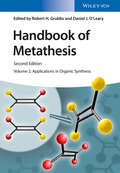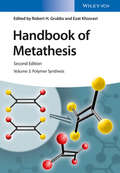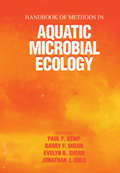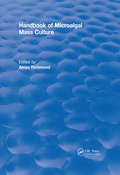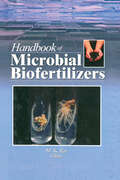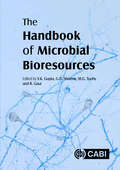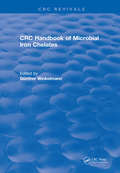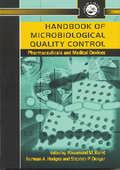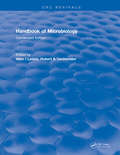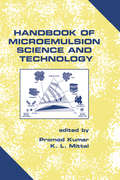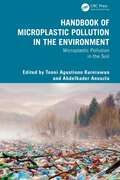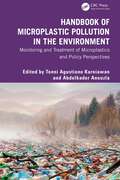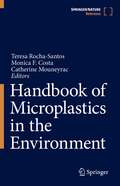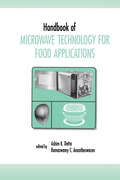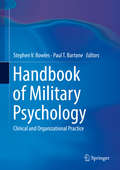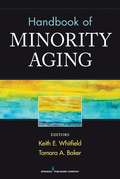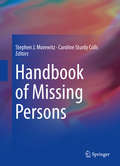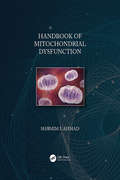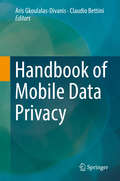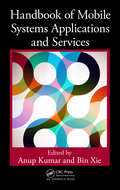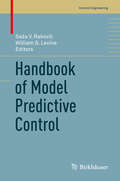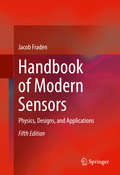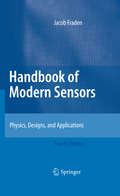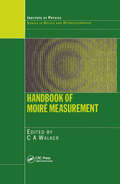- Table View
- List View
Handbook of Metathesis
by Robert H. Grubbs Daniel J. O'LearyThe second edition of the "go-to" reference in this field is completely updated and features more than 80% new content, with emphasis on new developments in the field, especially in industrial applications. No other book covers the topic in such a comprehensive manner and in such high quality. Edited by the Nobel laureate R. H. Grubbs and D. J. O´Leary, this volume 2 of the 3-volume work focusses on applications in organic synthesis. With a list of contributors that reads like a "Who's-Who" of metathesis, this is an indispensable one-stop reference for chemists in academia and industry. Other available volumes: Volume 1: Catalyst Development and Mechanism, Editors: R. H. Grubbs and A. G. Wenzel Volume 3: Polymer Synthesis, Editors: R. H. Grubbs and E. Khosravi
Handbook of Metathesis
by Robert H. Grubbs Ezat KhosraviThe second edition of this ultimate reference in this field is completely updated and features more than 80% new content, with emphasis on new developments in the field, especially in industrial applications. No other book covers the topic in such a comprehensive manner and in such high quality. Edited by the Nobel laureate R. H. Grubbs and E. Khosravi, this volume 3 of the 3-volume work focusses on polymer synthesis. With a list of contributors that reads like a "Who's-Who" of metathesis, this is an indispensable one-stop reference for chemists in academia and industry. Other available volumes: Volume 1: Catalyst Development and Mechanism, Editors: R. H. Grubbs and A. G. Wenzel Volume 2: Applications in Organic Synthesis, Editors: R. H. Grubbs and D. J. O´Leary
Handbook of Methods in Aquatic Microbial Ecology
by PAUL F. KEMP, BARRY F. SHERR, EVELYN B. SHERR AND JONATHAN J. COLEHandbook of Methods in Aquatic Microbial Ecology is the first comprehensive compilation of 85 fundamental methods in modern aquatic microbial ecology. Each method is presented in a detailed, step-by-step format that allows readers to adopt new methods with little difficulty. The methods represent the state of the art, and many have become standard procedures in microbial research and environmental assessment. The book also presents practical advice on how to apply the methods. It will be an indispensable reference for marine and freshwater research laboratories, environmental assessment laboratories, and industrial research labs concerned with microbial measurements in water.
Handbook of Microalgal Mass Culture (CRC Press Revivals)
by Amos RichmondThis handbook is devoted to the mass production of microalgae, and in my part, is based on some 10 years of experience in growing and studying microalgal cultures maintained at high polulation densities under laboratory conditions and in outdoor ponds
Handbook of Microbial Biofertilizers
by M. K. RaiSharply focused, up-to-date information on microbial biofertilizersincluding emerging options such as Piriformospora indica and MatsutakeThe Handbook of Microbial Biofertilizers provides in-depth coverage of all major microbial biofertilizers (rhizobia, arbuscular mycorrhizal fungi, and cyanobacteriaas well as new
Handbook of Microbial Bioresources, The
by Iqbal Ahmad Christian Cumagun Vinod Singh Alfredo Aires Harikesh Bahadur Singh Helen Treichel Pattanathu K.S.M. Rahman Jose López-Bucio Ram Naraian Quang D. Nguyen Hesham A. El Enshasy R. S. Upadhyay Ipek Kurtböke Javed Ahamad Khan Hector Cristóbal Igor Maksimov Sandipan Ganguly María-del-Carmen Durán-Domínguez-de-Bazúa M Neela Badrie Franciele M. Pelissari M. A. Mazutii Marina G. Holyavka Kanika Sharma Mark Eppinger Javier Hernández-Fernández Aakash Goyal Bishnu Maya Marcela Panago Ahmed M. El-Bondkly Gerardo Díaz Godínez Marcela Pagano Smriti Gaur Ravichandra Potumarthi Gustavo Molina Pradeep Kumar Shikha Shikha Gamini Seneviratne Jeyabalan Sangeetha Mohammed Kuddus S Chandra Nayak Thais Martins CostaMicrobial technology plays an integral role in the biotechnology, bioengineering, biomedicine/biopharmaceuticals and agriculture sector. This book provides a detailed compendium of the methods, biotechnological routes, and processes used to investigate different aspects of microbial resources and applications. It covers the fundamental and applied aspects of microorganisms in the health, industry, agriculture and environmental sectors, reviewing subjects as varied and topical as pest control, health and industrial developments and animal feed.
Handbook of Microbial Iron Chelates: A Person-centred Dialogue (CRC Press Revivals)
by Gunther WinkelmannHandbook of Microbial Iron Chelates emphasizes the various microbial compounds and synthetic analogues functioning as siderophores in microbes and as potential drugs in human iron metabolism. There are chapters describing the isolation, chemical characterization, synthesis and physicochemical properties of microbial iron chelates. Other chapters deal with the physiology and genetics of transport and receptors involved in iron uptake. Chemists, biologists, biochemists, pharmacologists, and medical doctors interested in the general aspects of iron metabolism, siderophores, receptors, and iron complex formation should consider this book a rich information source.
Handbook of Microbiological Quality Control in Pharmaceuticals and Medical Devices (Pharmaceutical Science Ser.)
by Norman A. Hodges Stephen P. Denyer Rosamund M. BairdMicrobiologists working in both the pharmaceutical and medical device industries, face considerable challenges in keeping abreast of the myriad microbiological references available to them, and the continuously evolving regulatory requirements. The Handbook of Microbiological Quality Control provides a unique distillation of such material, by provi
Handbook of Microbiology: Condensed Edition (Handbook Ser.)
by Allen I LaskinIncluded in the present volume are selected pages from Volume I, II, and IV of the CRC Handbook of Microbiology. Data from Volume II has not been included (microbial products), which did not lend itself readily to the selection of a few pages. As it is the present volume includes information about the various groups of microorganisms, their cell walls, and their genetics. Data on amino acids, carbohydrates, and lipids re included, together with diagrams of metabolic pathways and information on immunocompetent cells. General reference data include a glossary, statistical tables and other information that is hoped to be found useful by the reader.
Handbook of Microemulsion Science and Technology
by K. L. Mittal Promod KumarDemonstrating methods for overcoming stability issues in paints, wax dispersions, cosmetics, food products, and other industrial applications, this reference probes theoretical and practical issues surrounding microemulsion science and technology. Featuring the work of 51 international experts and containing almost 1000 instructive tables, equations, and illustrations, this book reviews the performance of, and prospects for, experimental methods such as X-ray diffraction, transmission electron microscopy (TEM), light scattering, small angle neutron scattering, viscosimetry, and nuclear magnetic resonance (NMR) to characterize various aspects of the dispersed phase of microemulsions.
Handbook of Microplastic Pollution in the Environment: Microplastic Pollution in Aquatic Environments
by Abdelkader Anouzla Tonni Agustiono KurniawanIn this timely handbook, one of a series of three, leading contributors from around the world offer practical insights into the challenges and opportunities for using various technologies to tackle microplastic pollution and improve microplastic management in aquatic environments.Through this book, readers will gain a deep understanding of microplastic pollution in both freshwater and marine environments and strategies and technologies to combat and manage this. To provide readers with this knowledge, the book is divided into four sections to explain microplastics in freshwater and marine environments and the impact of biofilm on microplastic pollution. The contributors first describe the characteristics of microplastics and their identification, roles in the pollution of aquatic environments, and impacts. They also describe microplastics in freshwater and marine environments through the use of case studies from both developing and developed countries from North America, Europe, Africa, and Asia. An introduction is provided at the beginning of each chapter for those interested in a brief synopsis, and copious references are provided for those wishing to study each chapter topic in greater detail. This book furnishes readers with the knowledge to reduce microplastics and prevent their improper disposal, which will prevent their intrusion and impact on biodiversity and ecosystems around the world and will also minimize economic losses caused by this emerging pollutant. For a wider perspective, readers are encouraged to refer to the other two titles in this series, subtitled Microplastic Pollution in the Soil and Monitoring and Treatment of Microplastics and Policy Perspectives.In its exploration of the relationships among the characteristics of microplastics, their mobility, transport pathways, and treatment, this handbook represents a vital practical guide for academics, industry-based researchers, and policymakers that paves the ways for a new direction of water technology for future wastewater treatment.
Handbook of Microplastic Pollution in the Environment: Microplastic Pollution in the Soil
by Abdelkader Anouzla Tonni Agustiono KurniawanIn this timely handbook, one of a series of three, leading contributors from around the world offer practical insight into the challenges and opportunities for using various technologies to tackle microplastic pollution and improve microplastic management in agricultural soil.Through this book, readers will gain a deep understanding of microplastic pollution in soils and its effects and knowledge of strategies and technologies to identify, monitor, and combat this. Early chapters describe microplastics in the rural environment, their accumulation, and their effects on soil biological processes and biodiversity, before moving on to address identification, analysis, and monitoring. Finally, they address innovative solutions for soil remediation, such as microbial strain engineering and other techniques. An introduction is provided at the beginning of each chapter for those interested in a brief synopsis, and copious references are provided for those wishing to study each chapter topic in greater detail. This book furnishes readers with the knowledge to identify and monitor microplastic levels in soil and reduce these to mitigate their harmful effects on soil biodiversity and ecosystems in agricultural soil, improving environmental and human health and minimizing economic losses. For a wider perspective, readers are encouraged to refer to the other two titles in this series, subtitled Microplastic Pollution in Aquatic Environments and Monitoring and Treatment of Microplastics and Policy Perspectives.In its exploration of the relationships among the characteristics of microplastics, their mobility, transport pathways, and treatment, this handbook represents a vital practical guide for academics, industry-based researchers, and policymakers worldwide to address soil biodiversity and ecological health.
Handbook of Microplastic Pollution in the Environment: Monitoring and Treatment of Microplastics and Policy Perspectives
by Abdelkader Anouzla Tonni Agustiono KurniawanIn this handbook, one in a series of three, leading global contributors analyze approaches to microplastics treatment, address advanced techniques for mediating microplastic pollution, and explore policy perspectives on the implications of microplastic pollution for human and ecosystem health.Through this book, readers will develop knowledge of leading and emerging technologies and techniques for monitoring and remediating microplastic pollution in the environment and understanding of the policy implications with regard to the human and ecological health risks associated with microplastic pollution. To achieve this, the book first explores current techniques for monitoring microplastics, such as remote sensing techniques, and their challenges and opportunities. In the second section, it then addresses policy perspectives on the management of microplastic pollution in aquatic environments and in agricultural soil. In taking a global approach to both sections, the contributors bring a wealth of knowledge and practical information to equip readers with a broad and up-to-date understanding of the geographical and ecological factors that can affect policy decisions. This enables readers to enact appropriate policies on the management and remediation of microplastic pollution that take into account the context and requirements of each individual situation. This, in turn, reduces the impact of microplastic pollution on biodiversity and ecosystems and minimizes the associated economic and human costs. For a wider perspective, readers are encouraged to refer to the other two titles in this series, subtitled Microplastic Pollution in Aquatic Environments and Microplastic Pollution in the Soil.In its exploration of the technologies and techniques for monitoring and treating microplastics and related policy perspectives, this handbook has deep implications and practical ramifications for academics, industry-based researchers, and policymakers to take a new direction to the reduction of microplastics in aquatic environments and agricultural soils around the world.
Handbook of Microplastics in the Environment
by Teresa Rocha-Santos Monica F. Costa Catherine MouneyracThis reference work presents an authoritative review of microplastics as vectors of environmental contaminants and provides a comprehensive coverage of their ecotoxicological and toxicological effects. Divided into four sections, this book outlines the current analytical techniques and applications for sampling, processing analysis, and data reporting of microplastics pollution in the environment, explores microplastics degradation and interaction with chemical pollutants, discusses the fate and behaviour of microplastics in the environment, and provides valuable insights about prevention, regulation and remediation of microplastics pollution. Written by interdisciplinary expert academics and practitioners, this reference work will appeal to a wide readership of students, researchers and professionals interested in this field, including marine scientists, environmental scientists, analytical chemists, organic chemists, biochemists, biologists, polymer scientists, and toxicologists.
Handbook of Microwave Technology for Food Application (Food Science and Technology)
by Ashim K. Datta Ramaswamy C. Anantheswaran"Integrates principles of electromagnetics, dielectrics, heat and moisture transfer, packaging, solid mechanics, fluid flow, food chemistry, and microbiology to provide a comprehensive overview of microwave processing in a single accessible source."
Handbook of Military Psychology
by Stephen V. Bowles Paul T. BartoneThis expert compendium surveys the current state of military psychology across the branches of service at the clinical, research, consulting, and organizational levels. Its practical focus examines psychological adjustment pre- and post-deployment, commonly-encountered conditions (e. g. , substance abuse), and the promotion of well-being, sleep, mindfulness, and resilience training. Coverage pays particular attention to uses of psychology in selection and assessment of service personnel in specialized positions, and training concerns for clinicians and students choosing to work with the military community. Chapters also address topics of particular salience to a socially conscious military, including PTSD, sexual harassment and assault, women's and LGBT issues, suicide prevention, and professional ethics. Among the specific chapters topics covered: #65533; Military deployment psychology: psychologists in the forward environment. #65533; Stress and resilience in married military couples. #65533; Assessment and selection of high-risk operational personnel: processes,procedures, and underlying theoretical constructs. #65533; Understanding and addressing sexual harassment and sexual assault in the US military. #65533; Virtual reality applications for the assessment and treatment of PTSD. #65533; Plus international perspectives on military psychology from China, Australia, India, and more. Grounding its readers in up-to-date research and practice, Military Psychology will assist health psychologists, clinical psychologists, psychiatrists, and clinical social workers in understanding and providing treatment for military populations, veterans, and their families, as well as military psychologists in leadership and consulting positions.
Handbook of Minority Aging
by Keith E. Whitfield Tamara A. BakerThe book focuses on the needs of four major ethnic groups: Asian/Pacific Islander, Hispanic/Latino, African American, and Native American. Key Features: Provides current, comprehensive information about minority aging through a multidisciplinary lens, Integrates information from scholars in gerontology, anthropology, psychology, public health, sociology, social work, biology, medicine, and nursing, Emphasizes the principal public health issues concerning minority elders, Offers "one-stop shopping" regarding the development of a substantial knowledge base about minority aging, Includes recent progressive research pertaining to the social, cultural, psychological and health needs of elderly minority adults in the US.
Handbook of Missing Persons
by Caroline Sturdy Colls Stephen J. MorewitzThis ambitious multidisciplinary volume surveys the science, forensics, politics, and ethics involved in responding to missing persons cases. International experts across the physical and social sciences offer data, case examples, and insights on best practices, new methods, and emerging specialties that may be employed in investigations. Topics such as secondary victimization, privacy issues, DNA identification, and the challenges of finding victims of war and genocide highlight the uncertainties and complexities surrounding these cases as well as possibilities for location and recovery. This diverse presentation will assist professionals in accessing new ideas, collaborating with colleagues, and handling missing persons cases with greater efficiency--and potentially greater certainty. Among the Handbook's topics: #65533;A profile of missing persons: some key findings for police officers. #65533;Missing persons investigations and identification: issues of scale, infrastructure, and political will. #65533;Pregnancy and parenting among runaway and homeless young women. #65533;Estimating the appearance of the missing: forensic age progression in the search for missing persons. #65533;The use of trace evidence in missing persons investigations. #65533;The Investigation of historic missing persons cases: genocide and "conflict time" human rights abuses. The depth and scope of its expertise make the Handbook of Missing Persons useful for criminal justice and forensic professionals, health care and mental health professionals, social scientists, legal professionals, policy leaders, community leaders, and military personnel, as well as for the general public.
Handbook of Mitochondrial Dysfunction
by Shamim I. AhmadMitochondria produce the chemical energy necessary for eukaryotic cell functions; hence mitochondria are an essential component of health, playing roles in both disease and aging. More than 80 human diseases and syndromes are associated with mitochondrial dysfunction; this book focuses upon diseases linked to these ubiquitous organelles. Accumulation of mitochondrial DNA damage results in mitochondrial dysfunction through two main pathways. Mutation in mitochondrial DNA causes diseases such as Kearns-Sayre syndrome and Pearson syndrome. Mutation in chromosomal DNA causes diseases such as Parkinson's disease and schizophrenia. These and many other diseases are reviewed in this book. Key Features Presents the detailed structure of mitochondria, mitochondrial function, roles of oxidants and antioxidants in mitochondrial dysfunction. Includes summary of both causes and effects of these diseases. Discusses current and potential future therapies for mitochondrial dysfunction diseases Explores a wide variety of diseases caused by dysfunctional mitochondria.
Handbook of Mobile Data Privacy
by Aris Gkoulalas-Divanis Claudio BettiniThis handbook covers the fundamental principles and theory, and the state-of-the-art research, systems and applications, in the area of mobility data privacy. It is primarily addressed to computer science and statistics researchers and educators, who are interested in topics related to mobility privacy. This handbook will also be valuable to industry developers, as it explains the state-of-the-art algorithms for offering privacy. By discussing a wide range of privacy techniques, providing in-depth coverage of the most important ones, and highlighting promising avenues for future research, this handbook also aims at attracting computer science and statistics students to this interesting field of research. The advances in mobile devices and positioning technologies, together with the progress in spatiotemporal database research, have made possible the tracking of mobile devices (and their human companions) at very high accuracy, while supporting the efficient storage of mobility data in data warehouses, which this handbook illustrates. This has provided the means to collect, store and process mobility data of an unprecedented quantity, quality and timeliness. As ubiquitous computing pervades our society, user mobility data represents a very useful but also extremely sensitive source of information. On one hand, the movement traces that are left behind by the mobile devices of the users can be very useful in a wide spectrum of applications such as urban planning, traffic engineering, and environmental pollution management. On the other hand, the disclosure of mobility data to third parties may severely jeopardize the privacy of the users whose movement is recorded, leading to abuse scenarios such as user tailing and profiling. A significant amount of research work has been conducted in the last 15 years in the area of mobility data privacy and important research directions, such as privacy-preserving mobility data management, privacy in location sensing technologies and location-based services, privacy in vehicular communication networks, privacy in location-based social networks, privacy in participatory sensing systems which this handbook addresses.. This handbook also identifies important privacy gaps in the use of mobility data and has resulted to the adoption of international laws for location privacy protection (e.g., in EU, US, Canada, Australia, New Zealand, Japan, Singapore), as well as to a large number of interesting technologies for privacy-protecting mobility data, some of which have been made available through open-source systems and featured in real-world applications.
Handbook of Mobile Systems Applications and Services (Mobile Services And Systems Ser. #1)
by Bin Xie Anup KumarFrom fundamental concepts and theories to implementation protocols and cutting-edge applications, the Handbook of Mobile Systems Applications and Services supplies a complete examination of the evolution of mobile services technologies. It examines service-oriented architecture (SOA) and explains why SOA and service oriented computing (SOC) will pl
Handbook of Model Predictive Control (Control Engineering)
by Saša V. Raković William S. LevineRecent developments in model-predictive control promise remarkable opportunities for designing multi-input, multi-output control systems and improving the control of single-input, single-output systems. This volume provides a definitive survey of the latest model-predictive control methods available to engineers and scientists today. The initial set of chapters present various methods for managing uncertainty in systems, including stochastic model-predictive control. With the advent of affordable and fast computation, control engineers now need to think about using “computationally intensive controls,” so the second part of this book addresses the solution of optimization problems in “real” time for model-predictive control. The theory and applications of control theory often influence each other, so the last section of Handbook of Model Predictive Control rounds out the book with representative applications to automobiles, healthcare, robotics, and finance. The chapters in this volume will be useful to working engineers, scientists, and mathematicians, as well as students and faculty interested in the progression of control theory. Future developments in MPC will no doubt build from concepts demonstrated in this book and anyone with an interest in MPC will find fruitful information and suggestions for additional reading.
Handbook of Modern Sensors
by Jacob FradenThe Handbook's coverage of sensors is extensive, ranging from simple photodiodes to complex devices containing components in combination. It offers hard-to-find reference data on the properties of numerous materials and sensing elements and emphasizes devices that are less well-known, whose technology is still being refined, and whose use permits the measurement of variables that were previously inaccessible.
Handbook of Modern Sensors: Physics, Designs, and Applications
by Jacob FradenThe Handbook's coverage of sensors is extensive, ranging from simple photodiodes to complex devices containing components in combination. It offers hard-to-find reference data on the properties of numerous materials and sensing elements and emphasizes devices that are less well-known, whose technology is still being refined, and whose use permits the measurement of variables that were previously inaccessible.
Handbook of Moire Measurement
by C. A. WalkerSince its development in the late 1970s, the Moire Fringe method has become a standard technique for the measurement of the behavior of materials and structures. Edited by one of the co-inventors of the technique, the Handbook of Moire Measurement brings together a series of extended case studies from recognized experts in the field. The emphasis i
